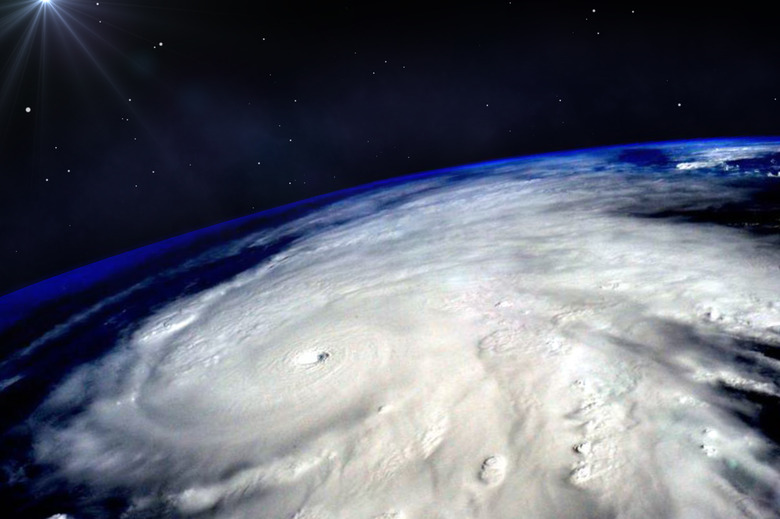What Happens When A Cold Front Meets A Warm Front?
Most people understand the basics of cold and warm fronts: Passage of a cold front cools things down, and passage of a warm front warms things up. But warm fronts and cold fronts don't simply follow one another in an orderly procession. They can also merge to form an occluded front, an important stage in the development of many significant low-pressure systems known as midlatitude cyclones.
TL;DR (Too Long; Didn't Read)
When a cold front overtakes a warm front, it creates what's called an occluded front that forces warm air above a frontal boundary of cooler air masses.
Types of Fronts and Mid Latitude Cyclone Action
Types of Fronts and Mid Latitude Cyclone Action
Cold fronts form when a cool air mass starts to displace warmer air in front of it. The colder dense air forces warmer air higher into the atmosphere. This warm air often then forms cumulus clouds or cumulonimbus clouds in the upper atmosphere, creating a storm front. Colder air masses are more likely to form thunderstorms (and even more catastrophic weather patterns like tornadoes or hurricanes).
Warm fronts form when a mass of warm air pushes into cooler air in front of it. The warm front passes over the cooler air mass in front, and the warm air rises into the air. Clouds often form, and precipitation is possible. Heavy rain and harsher weather conditions are usually reserved for cold front interactions, but they are still possible.
Warm fronts are often indicated with a red line dotted with red triangles, while cold fronts are marked with a blue line with blue semicircles. When these air masses meet at a boundary, it can lead to a stationary front (marked with alternating red and blue triangles and semicircles), but when the conditions are right it can also form an occluded front.
Midlatitude (or extratropical) cyclones – which shouldn't be confused with tropical cyclones or hurricanes – form along weather fronts, which are boundaries between air masses of different temperatures. A wave along the front creates a low-pressure disturbance, which draws in winds that – because of the rotation of the Earth – spiral around the low-pressure area. The leading edge of the warm air mass, where it rises over denser cold air, creates a warm front; that of the cold air mass behind, which shoves under the warm sector behind the warm front, creates a cold front.
Formation of an Occluded Front
Formation of an Occluded Front
In an occluded front, the trailing cold front overtakes the preceding warm front. This is conventionally described as the cold front "catching up" to the warm front. However, while it's true that cold fronts tend to move faster than warm fronts, recent meteorology research suggests more underlying cyclonic processes cause the frontal mashup. Regardless, an occluded front involves the warm air behind the warm front behind forced aloft, the low-pressure center of the cyclone moving away from the frontal boundary, and the cold front coming into contact with the cold air mass originally downwind (so to speak) of the warm front.
This mixing can cause further weather systems to develop, but occluded fronts are often a sign of the storm beginning the end of its lifecycle. Cumulonimbus and nimbostratus clouds form, and stormy weather may continue, but the storm has reached maturation as the occluded front forms.
TL;DR (Too Long; Didn't Read)
Occluded fronts typically form around areas of low atmospheric pressure.
Warm-type vs. Cold-type Occlusions
Warm-type vs. Cold-type Occlusions
Two types of occluded front exist: the warm-type and the cold-type. They're distinguished by the relative temperatures of the air mass ahead of the occlusion – in other words, the air mass ahead of the original warm front – and the air mass behind the cold front. If the air behind the cold front is colder than the air ahead of the occlusion, it shoves beneath that air (because it's denser) to form a cold-type occluded front. If the air behind the cold front is warmer than the air ahead, it rides over it to form a warm-type occluded front – which appears to be the more common case. In either situation, the lighter warm air representing the air mass originally between the warm and cold fronts sits above the boundary between the two cooler air masses.
Occluded Front Weather Map Symbols
Occluded Front Weather Map Symbols
Colored weather maps represent cold fronts with blue lines studded with blue triangles pointing in the direction of the front's movement. Warm fronts appear as red lines marked with red half-circles that also point toward the direction of frontal movement. An occluded front shows on the map as a combination of these symbols: a purple line alternating with purple triangles and half-circles.
Weather Along the Occluded Front
Weather Along the Occluded Front
A forward-moving front, whether warm or cold, causes one air mass to lift above another; by forcing the air mass to its condensation level, this creates clouds and often precipitation. Weather along an occluded front can take many forms, but some combination of cold-front and warm-front effects often takes place, with anything from light to heavy precipitation often diminishing to clear skies after the front's passage.
Weather is also highly dependent on the air pressure of the surrounding area. Low pressure is typically an indicator of more extreme weather, while high pressure often marks moderate weather patterns.
Cite This Article
MLA
Shaw, Ethan. "What Happens When A Cold Front Meets A Warm Front?" sciencing.com, https://www.sciencing.com/happens-front-meets-warm-front-8402437/. 8 July 2023.
APA
Shaw, Ethan. (2023, July 8). What Happens When A Cold Front Meets A Warm Front?. sciencing.com. Retrieved from https://www.sciencing.com/happens-front-meets-warm-front-8402437/
Chicago
Shaw, Ethan. What Happens When A Cold Front Meets A Warm Front? last modified July 8, 2023. https://www.sciencing.com/happens-front-meets-warm-front-8402437/
